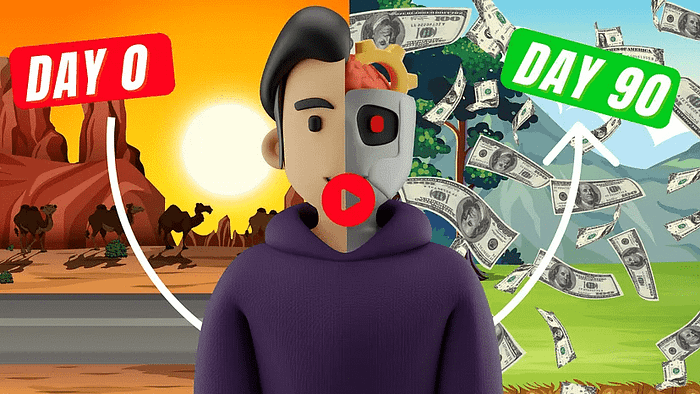5 Mental Models That Silicon Valley Leaders Use Daily
Navigating Life’s Chessboard with Mental Models
As I reflect on my journey through life, I’ve come to realize that mental models are the guiding light that illuminate the path to success. Just as a compass guides a traveler through uncharted territory, these powerful frameworks help us navigate the complex decisions we face every day.
Growing up, I was fascinated by the game of chess. I spent countless hours studying the intricacies of the game, analyzing different strategies, and honing my skills. Little did I know that the lessons I learned on the chessboard would become invaluable mental models for tackling challenges in business and life.
In this article, I’ll share with you five mental models that have transformed the way I approach strategic thinking. These frameworks, borrowed from the world of competitive chess, will equip you with the tools you need to make better decisions, overcome obstacles, and achieve your goals.
We strongly recommend that you check out our guide on how to take advantage of AI in today’s passive income economy.
Table of Contents
1. Control the Center: Establishing Your Strategic Foothold
In the game of chess, controlling the center of the board is paramount. The player who dominates the four squares in the middle enjoys a massive strategic advantage, as their pieces have maximum influence and reach across the battlefield.
Imagine a chessboard stretched out before you. The center squares are like the high ground, offering a commanding view of the entire field. From this vantage point, your pieces can move swiftly, exerting their power and control over the surrounding squares.
The same principle applies in life and business. To think strategically, you must identify the key areas that will give you the most leverage and influence. These are your “center squares,” the critical points that, when controlled, can tilt the odds in your favor.
For example, let’s say you’re trying to lose weight. The chessboard of weight loss is vast, with countless squares representing different strategies and tactics. But which squares hold the most power? Is it exercise? Nutrition? Sleep? Fad diets?
Upon closer examination, you’ll find that the center of the weight loss chessboard lies in two fundamental squares: burning more calories and consuming fewer calories. These are the key levers that, when pulled, can lead to significant progress.
Now, imagine you’re a busy professional with limited time and resources. You can only focus on one of these squares. Which one should you choose? Scientific evidence suggests that nutrition is the more influential factor. You can’t outrun a poor diet, as the saying goes.
The same mental model applies to business. As an entrepreneur, you’re constantly juggling multiple aspects of your venture – marketing, operations, finance, and more. Each of these areas is a square on your business chessboard. But which ones are the most critical to control?
In the early stages of a business, the center squares are often product development and customer acquisition. Without a solid product and a growing customer base, the other squares become less relevant. As your business matures, the center squares may shift to operational efficiency, financial management, or scaling your team.
By identifying and focusing on the center squares, you can allocate your resources strategically, maximizing your impact and increasing your chances of success.
2. Understand the True Value of a Piece: Assessing Your Resources
In chess, each piece has a different value. Pawns are worth one point, knights and bishops are worth three, rooks are worth five, and the queen is worth a staggering nine points. These values provide a quick way to assess the strength of each player’s army at any given moment.
However, the true value of a piece goes beyond its assigned point value. It’s relative to the board dynamics and the specific situation at hand. A knight in the center of the board, for instance, has far more influence and potential than a knight tucked away in the corner.
This mental model teaches us to look beyond surface-level assessments and consider the context in which our resources are deployed. In business, your resources are your people, your capital, your technology, and your expertise. Each of these “pieces” has a different value depending on how they are positioned and utilized.
Imagine you’re a startup founder building your team. You have a limited budget and can only hire a handful of people. How do you assess the value of each potential hire? It’s not just about their individual skills and experience; it’s about how they fit into the larger puzzle of your company.
A highly skilled engineer may be worth their weight in gold if they are working on a critical project that can make or break your business. On the other hand, a mediocre salesperson in a key market can be more valuable than a top-performing salesperson in a less significant territory.
The same principle applies to your personal life. The people in your network, the skills you possess, the knowledge you’ve acquired – these are all pieces on your life’s chessboard. Their true value lies in how you position them and leverage them to achieve your goals.
By understanding the contextual value of your resources, you can make strategic decisions about where to invest your time, energy, and capital. You can identify the key players in your organization, the critical projects that require your attention, and the opportunities that offer the highest return on investment.
3. Position Before Submission: Laying the Groundwork for Success
In martial arts, there’s a common misconception among beginners that the goal is to constantly seek the submission – the knockout punch, the decisive takedown, the match-ending choke. They throw wild punches and reckless attacks, hoping to end the fight in one fell swoop.
But experienced fighters know better. They understand that before you can go for the submission, you must first control the position. They patiently maneuver their opponent, securing advantageous positions that limit their opponent’s options and increase their own chances of success.
The same mental model applies in chess, business, and life. Novice players are often fixated on achieving checkmate at all costs, even if it means sacrificing their own position in the process. They chase after quick wins and easy solutions, neglecting the foundational work required for long-term success.
In contrast, strategic thinkers focus on controlling the position before seeking the submission. They invest time and effort in building a strong foundation, developing their skills, and creating an environment that is conducive to their goals.
Imagine you’re an aspiring entrepreneur dreaming of building a successful business. The temptation is to jump straight into the fray, chasing after customers and revenue without a solid plan in place. But this approach is like throwing wild punches in a fight – you might land a few lucky hits, but you’re unlikely to achieve lasting success.
Instead, strategic entrepreneurs focus on controlling the position first. They invest in market research, product development, and building a strong team. They create systems and processes that can scale with their business. They cultivate relationships with key stakeholders and build a reputation for excellence.
By laying this groundwork, they create a slippery slope towards their goals. When opportunities arise, they are well-positioned to seize them. When challenges emerge, they have the resilience and resources to overcome them.
The same principle applies to personal development. Many people chase after quick fixes and shortcuts, hoping to transform their lives overnight. They jump from one fad diet to another, from one self-help book to the next, without ever building a solid foundation.
But true growth and transformation require patience and persistence. They require investing in yourself, developing your skills, and creating an environment that supports your goals. By focusing on controlling the position – your mindset, your habits, your relationships – you lay the groundwork for lasting success.
4. Own the Initiative: Seizing the Momentum
In chess, there’s a secret weapon that grandmasters use to evaluate positions and predict outcomes. It’s not just about counting pieces or controlling territory – it’s about owning the initiative.
The initiative refers to which player is dictating the action, setting the pace, and forcing their opponent to react. The player with the initiative has the upper hand, even if they have fewer pieces or less control of the board.
History is filled with examples of underdogs who prevailed against overwhelming odds by seizing the initiative. Napoleon, despite often having inferior forces, managed to win time and time again by dictating the terms of engagement.
In business and life, owning the initiative is the X-factor of success. It’s the difference between being proactive and reactive, between leading and following, between creating your own opportunities and waiting for them to come to you.
When you own the initiative, you have momentum on your side. Momentum is the cure to procrastination, overwhelm, and overthinking. It’s the force that propels you forward, even when the odds are stacked against you.
But here’s the catch: momentum is hard to get started. It requires a massive upfront investment of energy and effort – what’s known as activation energy. This is why many people struggle to get traction in their lives and businesses. They’re stuck in a state of inertia, unable to overcome the initial resistance.
However, once you get momentum going, it becomes easier to sustain. The energy required to maintain progress is far less than the energy needed to get started. This is why successful people often make success look effortless – they’ve already put in the hard work to build momentum.
To own the initiative in your life and business, you need to be proactive. You need to take bold action, even when you don’t feel ready. You need to create your own opportunities, rather than waiting for them to come to you.
This might mean starting that business idea you’ve been sitting on for years, even if you don’t have all the details figured out. It might mean reaching out to that potential mentor or collaborator, even if you feel intimidated. It might mean taking that first step towards your goals, even if the path ahead is uncertain.
By seizing the initiative, you set yourself up for success. You create a positive feedback loop of action and results, building momentum that carries you forward.
5. The Hardest Move to Find: Embracing Strategic Retreats
In chess, the hardest move to find is often the knight retreat. This is because the knight moves in a unique way, jumping over other pieces in an L-shaped pattern. It’s also because retreating feels counterintuitive – we often associate backward movement with failure or loss.
But sometimes, taking a step back is the fastest way to move forward. Strategic retreats allow us to regroup, reassess, and come back stronger. They give us the space to let go of what’s not working and focus on what truly matters.
In business, this might mean firing a difficult client, even if it means taking a short-term hit to your revenue. It might mean pivoting your product or business model, even if it means admitting that your initial assumptions were wrong. It might mean saying no to opportunities that don’t align with your values or goals, even if they seem lucrative on the surface.
In your personal life, a strategic retreat might mean ending a toxic relationship, even if it means being alone for a while. It might mean quitting a job that’s making you miserable, even if it means taking a pay cut. It might mean letting go of a long-held belief or identity that’s no longer serving you, even if it means facing uncertainty and discomfort.
The key is to reframe retreats as strategic moves, rather than failures or setbacks. By taking a step back, you create space for new opportunities to emerge. You free up mental and emotional energy that was being drained by unproductive pursuits. You gain clarity on what truly matters to you.
Of course, retreating is never easy. It requires courage, self-awareness, and a willingness to let go of sunk costs. But the payoff can be immense. By embracing strategic retreats, you open yourself up to new possibilities and paths forward.
Conclusion: Mastering the Game of Life
Chess is often used as a metaphor for life, and for good reason. The strategies and mental models that lead to success on the chessboard are just as applicable to the boardroom and beyond.
By controlling the center, understanding the true value of your resources, focusing on position before submission, owning the initiative, and embracing strategic retreats, you can navigate the complexities of life and business with greater clarity and confidence.
But mastering these mental models is not a one-time event. It’s a lifelong journey of learning, experimentation, and growth. Just as a chess player must continually study and refine their skills, we must continually invest in our own development and adapt to new challenges and opportunities.
The beauty of mental models is that they are not fixed or rigid. They are flexible frameworks that can be applied to a wide range of situations and contexts. By internalizing these models and making them your own, you can unlock your full potential as a strategic thinker and decision-maker.
So embrace the game of life. Study the board, assess your pieces, and make your moves with intention and purpose. And remember, even when the odds seem stacked against you, there’s always a winning strategy waiting to be found.

We strongly recommend that you check out our guide on how to take advantage of AI in today’s passive income economy.




